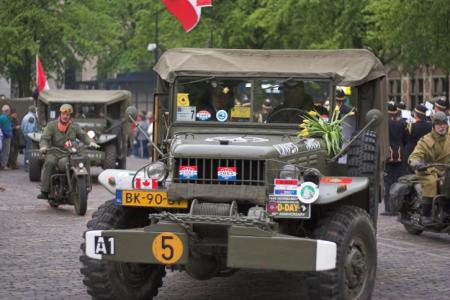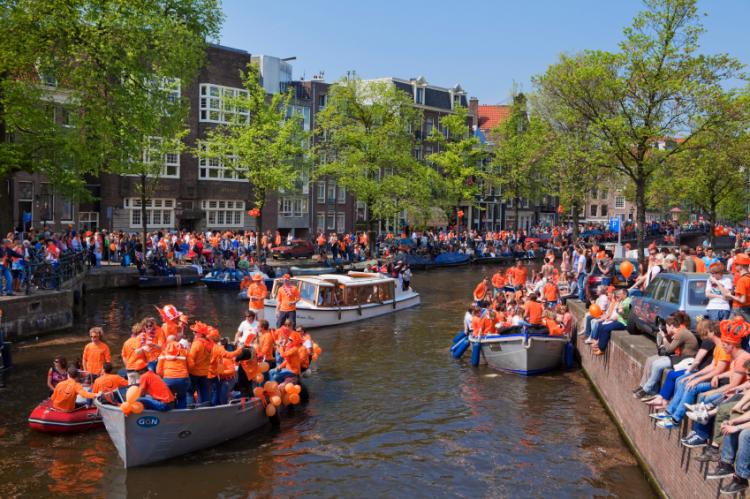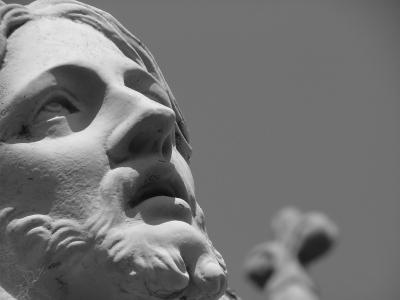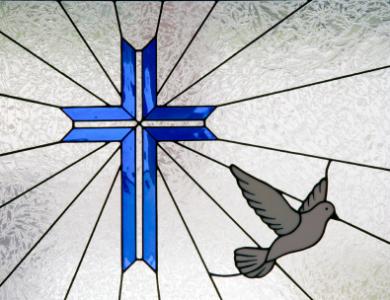
Liberation Day
Liberation Day in the Netherlands celebrates the end of World War II in Europe.
The Queen's official birthday (Queen's Day, koninginnedag) on April 30 was celebrated in the Netherlands each year until 2013. In 2014, following Queen Beatrix’s abdication, it was replaced by King's Birthday, which falls on April 27.
Dutch employees are not legally entitled to a day off on public holidays. Schools, offices, businesses, and stores may be closed or open.

People in Amsterdam celebrate the Queen's Day.
©iStockphoto.com/sara_winter
In many towns and cities, particularly Amsterdam, Arnhem, Utrecht and The Hague, the Queen's Day celebrations began on the evening of April 29. There were public music performances and street parties. Some events continued until daybreak when the actual Queen's Day events began.
Many people in the Netherlands had a day off work and schools were closed on April 30. It was the only day in the year when people without licences to trade were allowed to sell things on the street. Some people set up stalls to sell second-hand goods and Queen's Day themed products in many city and town centers.
Street performers and official musical performances entertained the crowds on Queen's Day. Many people spontaneously sang "Het Wilhelmus". This is a poem written in 1574 that describes the life of William of Orange (William the Silent) and his fight for the Dutch people. It is written as if William of Orange is introducing himself to the Dutch people. Versions were also played by bands performing at Queen's Day events and on radio stations.
Each year, the royal family visited one or a few places on April 30. There they were entertained with displays and performances around local historic events. The members of the royal family generally joined in with the games in a good-natured way and greeted thousands of people who turned out to see them.
Until 2013, banks, post offices and many businesses were closed on April 30. Some stores were open as usual, some were open for part of the day, and some were closed all day. Public transport ran to a normal or special timetable and there were extra train services to take people home from large celebrations. However, buses and trams in the center of large cities may have had different or shortened routes to avoid the crowds. Restaurants may have been shut, open as usual or only serving special "Queen's Day" meals. Cafes and restaurants may have closed earlier than usual.
Due to mass celebration, it was difficult to reach many addresses in the center of large cities, especially Amsterdam by most forms of transport. Apart from minor criminal acts such as pick pocketing and urinating in public, Queen's Day events were usually very peaceful. If April 30 fell on a Sunday, the celebrations tool place on Saturday, April 29.
On August 31, 1880, Princess Wilhelmina was born in The Hague. She was the last child of King William III and the only child to outlive him. On August 31, 1885, and on the same date each year after that public birthday celebrations were held for her. The occasion was originally known as Princesses Day (Prinsessedag) and became known as Queen's Day in 1890 after Wilhelmina became Queen following the death of her father. On August 31, 1902, people in the Netherlands heard that Queen Wilhelmina had recovered from typhus and Queen's Day became a true public celebration.
On September 6, 1948, Wilhelmina's daughter, Juliana became queen and from 1949, the Queen's Day celebrations were moved to April 30, her birthday. On April 30, 1980, Beatrix, Juliana's daughter, became queen. Her birthday is on January 31, but the date of Queen's Day remained the same as a way of honoring Juliana. Hence, Queen's Day was the Queen's official birthday and the anniversary of her coronation.
The national flag of the Netherlands is a horizontal tricolor with red at the top, white in the middle and blue at the bottom. On some feast days, an orange strip of cloth, known as a wimpel, is hung above the national flag. This is a symbol for the Dutch royal family, which uses the name "House of Orange-Nassau". The national flag and the colors red, white, blue and orange were widely displayed on Queen's Day. On national holidays like Queen's Birthday or King's Birthday, many people make a special effort to wear an orange item of clothing, to dye their hair orange or to color their faces orange. Accessories that combine the color orange with some symbol of the royal family, such as a crown or a lion, are especially popular and sought after.
The traditional drink on holidays like Queen's Day is oranje bitter. This is made by soaking the peel of bitter oranges (Citrus aurantium) in jenever, a strong alcoholic drink sometimes known as gin. The resulting liquid is bright orange. A lot of other orange food items are prepared for days like Queen's Day. These include: cakes; custard slices with orange icing or filling; white chocolate; and soft drinks.
Queen's Birthday in the Netherlands has not been observed since 2013.
| Year | Weekday | Date | Name | Holiday Type |
|---|---|---|---|---|
| 2000 | Sun | Apr 30 | Queen's Birthday | Public Holiday |
| 2001 | Mon | Apr 30 | Queen's Birthday | Public Holiday |
| 2002 | Tue | Apr 30 | Queen's Birthday | Public Holiday |
| 2003 | Wed | Apr 30 | Queen's Birthday | Public Holiday |
| 2004 | Fri | Apr 30 | Queen's Birthday | Public Holiday |
| 2005 | Sat | Apr 30 | Queen's Birthday | Public Holiday |
| 2006 | Sun | Apr 30 | Queen's Birthday | Public Holiday |
| 2007 | Mon | Apr 30 | Queen's Birthday | Public Holiday |
| 2008 | Wed | Apr 30 | Queen's Birthday | Public Holiday |
| 2009 | Thu | Apr 30 | Queen's Birthday | Public Holiday |
| 2010 | Fri | Apr 30 | Queen's Birthday | Public Holiday |
| 2011 | Sat | Apr 30 | Queen's Birthday | Public Holiday |
| 2012 | Mon | Apr 30 | Queen's Birthday | Public Holiday |
| 2013 | Tue | Apr 30 | Queen's Birthday | Public Holiday |
While we diligently research and update our holiday dates, some of the information in the table above may be preliminary. If you find an error, please let us know.

Liberation Day in the Netherlands celebrates the end of World War II in Europe.

Ascension Day (hemelvaart) in the Netherlands is the 40th day of Easter and ten days before Pentecost.

Mother’s Day celebrates the achievements and efforts of mothers and mother figures.

Pentecost (Pinksteren) in the Netherlands is seven weeks after Easter Sunday. It commemorates the Holy Spirit's descent from heaven onto Jesus' followers.